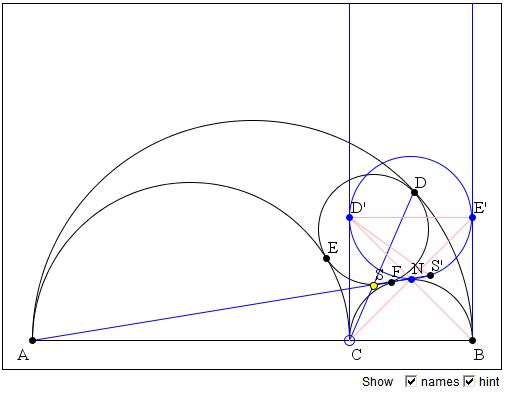Concurrency in Arbelos: What is this about?
A Mathematical Droodle
| What if applet does not run? |
|Activities| |Contact| |Front page| |Contents| |Geometry|
Copyright © 1996-2018 Alexander BogomolnyArbelos is a geometric shape bounded by three semicircles. In the applet these are AC, CB and AB. Assume M is the midpoint of the semicircle on the diameter AC, N that of the semicircle CB. A circle is inscribed in the arbelos tangent to the semicircles in points E, F, and D. Then the lines AN, BM and CD are concurrent. The point of concurrency lies on the incircle.

The statement above and the proof below are from [Woo].
Proof
Perform an inversion with center A and power AC·AB. This will invert B into C and vice versa. Hence the circle on the diameter CB is stationary. The big semicircle inverts into the line perpendicular to AB at C, and the left semicircle into a line perpendicular to AB at B. The incircle of the arbelos that is tangent to all three semicircles inverts into the circle tangent to the two vertical lines and the right semicircles. The image of F is N, the topmost point of the semicircle on BC. The images D' and E' of the points D and E lie on the vertical lines and, therefore form a diameter D'E' of the inversive image of the incircle. By Archimedes' Proposition 1, or due to the local symmetry of the configuration, points B, N, and D' are collinear.
Let S be the point of intersection of AN with the incircle other than F and S' its inversive image.
∠AS'D' = ∠NS'D' = ∠NE'D' = 45°.
Also, ∠ABD' = 45°. Therefore, the points A, B, S', D' are concyclic. The inversive image of their circle is the straight line that passes through C, S and D. We see that S lies on CD, with the conclusion that CD and AN meet (in S) on the incircle. Considering inversion centered at B, we get a similar conclusion that CD and BM meet in S on the incircle.
Remark
Note that the statement just proved provides a construction of the incircle: first, find the midpoints points M and N. Then, find S as the intersection of AN and BM. Finally, D is the intersection of CS with the big semicircle.
References
- P. Y. Woo, Simple Constructions of the Incircle of an Arbelos, Forum Geometricorum, V. 1 (2001), 133-136
- Arbelos - the Shoemaker's Knife
- 7 = 2 + 5 Sangaku
- Another Pair of Twins in Arbelos
- Archimedes' Quadruplets
- Archimedes' Twin Circles and a Brother
- Book of Lemmas: Proposition 5
- Book of Lemmas: Proposition 6
- Chain of Inscribed Circles
- Concurrency in Arbelos
- Concyclic Points in Arbelos
- Ellipse in Arbelos
- Gothic Arc
- Pappus Sangaku
- Rectangle in Arbelos
- Squares in Arbelos
- The Area of Arbelos
- Twin Segments in Arbelos
- Two Arbelos, Two Chains
- A Newly Born Pair of Siblings to Archimedes' Twins
- Concurrence in Arbelos
- Arbelos' Morsels
|Activities| |Contact| |Front page| |Contents| |Geometry|
Copyright © 1996-2018 Alexander Bogomolny73578894
